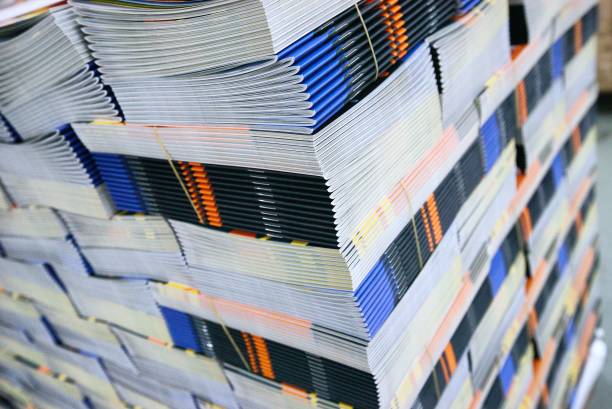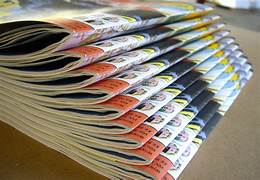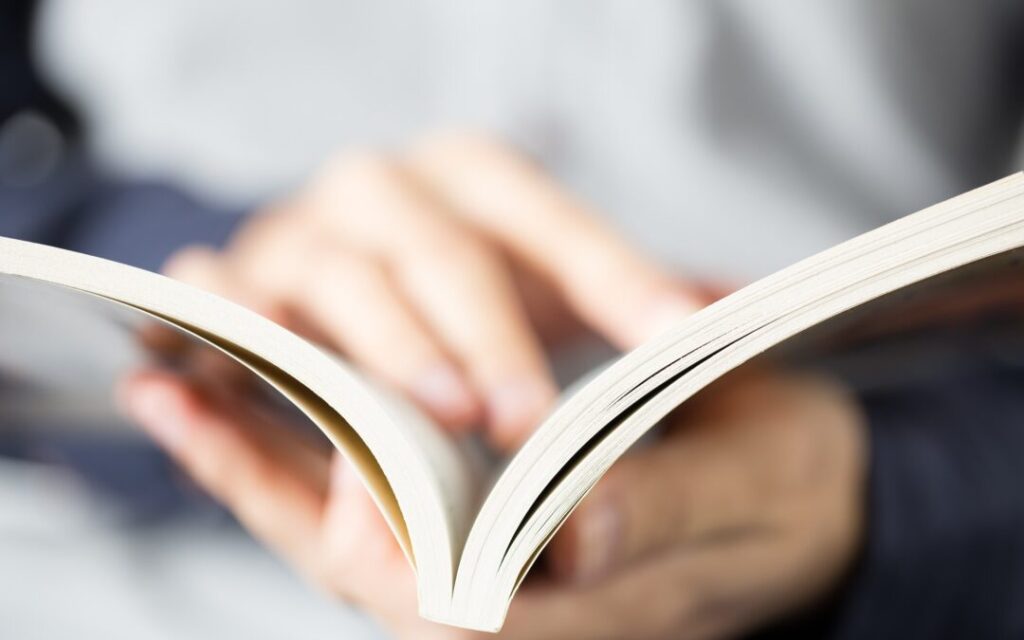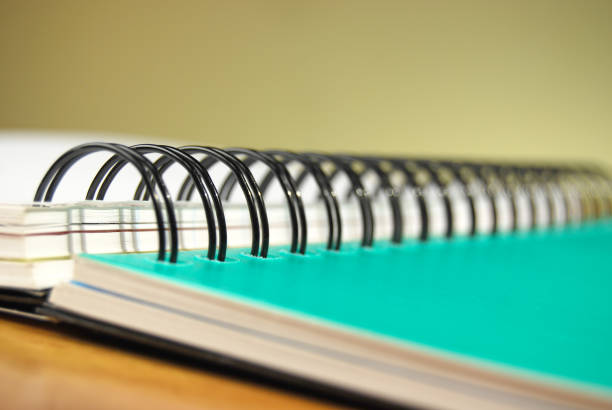
The choice of binding method significantly influences the look, use, and price of a printed item. Stapled book printing, or saddle stitch binding, is a commonly chosen method. It involves placing paper sheets inside each other and securing them by staples on the fold. This is perfect for items like booklets, reports, or catalogs with up to 48 pages, says the first source.
Saddle stitch is highlighted as affordable and widely available, great for many booklets and publications, notes the second source. But, it does come with constraints. For one, a high page count can lead to staples popping out. Also, there’s the issue of “creep,” where inner pages slightly stick out, more visible in larger publications. The third source delves deeper into saddle stitch’s pros and cons. It also contrasts it with other methods like perfect binding and spiral binding.
Introduction to Book Binding Methods
Choosing the right book binding method is key in crafting the perfect book. It affects not just the look, but also the feel and life of the product. Whether it’s the economical saddle stitch for high-quality print booklets with features like anti-crease square edge in line spine and no cracking at the spine, or the flexible perfect and spiral bindings, there are options for all needs.
Popular Book Binding Techniques
In Australia, perfect binding and saddle stitch booklets are commonly used. Perfect binding, or adhesive binding, works well for softcovers and more. It gives a sleek appearance and allows printing on the spine. On the flip side, spiral binding lets publications lie flat, perfect for tech manuals and notebooks.
Factors to Consider When Choosing a Binding Method
Choosing the ideal binding method depends on various factors. These include the final look you want, how many pages you have, its purpose, and your budget. Saddle stitch is budget-friendly, perfect binding is both durable and customizable, and spiral binding is extremely versatile. Additionally, opting for a thicker cover can provide a premium quality, professional finish, especially for smaller sized booklets such as DL and square booklets. Knowing the pros and cons of each method, including the option of a thicker cover, will help you decide wisely for your project.
Stapled Book Printing

The saddle stitch binding method, also known as stapled book printing, is a beloved choice for a range of materials, including stapled booklets. These booklets can be A4 gloss stapled booklets, uncoated paper stapled booklets, or professional stapled booklets, making them ideal for newsletters, catalogues, and magazines. The process involves placing the sheets inside each other and stapling them at the fold. This final touch not only looks professional but also attracts the eye with its compact form.
What is Stapled Book Printing and Binding (Saddle Stitching)?
Saddle stitch binding is favored for its accessibility and budget-friendliness. It involves placing paper sheets within each other and stapling them at the fold. Mainly applied to booklets or thinner books, it accommodates up to 64 pages. Each booklet’s page count must be divisible by four to manage the folding efficiently – two inside and two outside pages, forming one folded sheet.
Advantages of Saddle Stitch Binding
Choosing saddle stitch binding boasts a variety of benefits. It’s an economical method that ensures quick results, perfect for brochures and similar items. Its neat appearance, thanks to wire staples and nested sheets, elevates the quality of the final print. Additionally, supplying booklet artwork as individual pages is crucial to ensure the correct page order and correspondence with the PDF document.
Limitations of Stapled Book Printing & Binding (Saddle Stitching )
Despite its pros, saddle stitch binding isn’t flawless. It’s more suitable for thinner publications, as the staples might not hold well with too many pages. Another issue is the creep effect; as pages move towards the booklet’s center, they may appear to shrink. This can be countered by reducing page numbers or adding blank sheets, advice often given by printers to guarantee a satisfying finish. Additionally, saddle stitch binding may not be ideal for a landscape booklet due to larger sheets and higher production costs.
Perfect Binding: An Alternative to Stapled Book Printing

Saddle stitch binding is a known and budget-friendly method. However, for publications needing more pages, perfect binding is a solid choice. It’s ideal for softcover options like books, magazines, or manuals. Additionally, perfect binding offers the versatility of self cover booklets, allowing the use of the same high-quality paper throughout or opting for thicker covers.
Understanding Perfect Binding
Perfect binding uses glue to attach the book’s pages along the spine. With adhesives like PUR glue, it creates a flat spine. This method is perfect for books with over 96 pages, offering durability and a sleek finish for softcover publications.
Pros of Perfect Binding: Thicker Cover
Perfect binding presents a crisp, professional look and is highly durable. It also allows printing on the spine. It’s a popular choice for hardcover books due to its strength, customizability, and the way it boosts the book’s appearance.
Cons of Perfect Binding
Despite its benefits, perfect binding is pricier and slower than Stapled Book Printing. The flat spine can also hinder hands-free reading. This might not suit materials like recipe books or manuals where keeping the book open is key.
Comparison: Stapled Book Printing (Saddle Stitch) vs. Perfect Binding
When deciding on book binding methods in Australia, saddle stitch and perfect binding stand out. They each have unique benefits and points to consider. These help in picking the best fit for your publication.
Saddle stitch is the go-to for smaller, budget-conscious projects like pamphlets and thin magazines. It shines with its economic edge and quick production. It’s also an environmentally friendly choice, needing no glue and reducing paper waste. Additionally, saddle stitch binding is perfect for creating unique and innovative square booklets, which can set your brand apart and leave a lasting impression.
If your book has more than 96 pages or needs specific customisations, perfect binding is ideal. This method creates a professional look and offers freedom in design. Books bound this way look sleek without a seam on the spine. However, it comes at a higher cost and takes a bit longer to produce.
Despite its advantages, perfect binding isn’t great for books that you read while cooking or building, since it doesn’t lay flat easily. This is crucial information for those considering it for recipe books or manuals.
In conclusion, choosing between saddle stitch and perfect binding depends on your book’s requirements. Consider the look you’re going for, your budget, its purpose, and the number of pages. Understanding what each method excels at will guide your decision towards the most suitable option for your project.
Spiral Binding: A Versatile Option

In the domain of book binding, spiral binding has proven itself highly adaptable. It offers numerous advantages, rendering it a valuable choice for diverse uses. Unlike conventional methods, such as stapling or perfect binding, spiral binding allows pages to turn a full 360 degrees. This feature is especially beneficial for textbooks, reports, and cookbooks. It caters to situations requiring the reader’s hands to be free, enhancing the user experience. Additionally, spiral binding works well with uncoated paper, making it an excellent option for budget booklets.
Benefits of Spiral Binding
Spiral binding excels in its capacity to lay notebooks and books flat, allowing for easy note-taking or content reference. It facilitates a seamless interaction with the material. Thus, making spiral bound notebooks a top choice wherever hands-free reading is essential. This includes educational environments and business settings during presentations.
Furthermore, the technology behind spiral binding supports a vast array of customization options. Users can pick from a variety of cover materials, colors and page designs. This adaptability ensures that spiral bound notebooks can align with personal preferences or corporate branding. Hence, each product can be uniquely tailored to its intended user or business.
Design Considerations for Spiral Bound Notebooks
Creating a spiral bound notebook requires attention to several design aspects. The durability of the spiral is paramount, given the extensive use spiral-bound items often endure. This is met by employing high-quality metal or plastic coils. These coils are robust, standing up to daily handling.
Additionally, the design of spiral bound notebooks permits the use of various paper types and layouts. This flexibility allows for customized solutions that meet specific needs or preferences. The combination of this design freedom with the benefits of spiral binding elevates spiral bound notebooks as a preferred option. They are ideal for an assortment of uses.
Cost Considerations for Stapled Book Printing and Spiral Bound Book Printing
Choosing the correct binding method is key, especially if cost plays a significant role. The cost differences between saddle stitch binding and spiral binding are well explained in the first two sources.
Saddle stitch binding is often heralded as more affordable than spiral binding. The process involves simple stapling, leading to lower expenses. Thus, it’s ideal for those working within tight budget constraints or those who print regularly.
Nevertheless, the second source brings to light the advantages of spiral binding. While slightly more expensive, its benefits in durability and ease of use are significant. It holds up better to frequent use and avoids the issues of staple damage and page creep.
When making a choice, it’s crucial to consider the binding costs within the context of your needs. Think about the look you’re aiming for, the book’s purpose, and your budget. In doing so, you will select the binding method that is both cost-effective and appropriate for your project. Additionally, consider the type of paper stock you will use, as it can impact both the cost and the final appearance of your booklet.
Choosing the Right Page Count for Your Binding Method

When choosing a binding method, the page count plays a vital role. It’s essential to know the limits and ideal page ranges for each type. This helps ensure your project’s quality and functionality. Additionally, considering the booklet size allows you to customize the size of the booklet along with other options such as the type of booklet, amount of pages, cover options, binding options, paper stock, and time frames.
Page Limits for Stapled Book Printing (Saddle Stitching)
Saddle stitch binding or stapled book printing is ideal for smaller projects. It works well with saddle stitched booklets and books having 8 to 64 pages. The maximum page count for this method is theoretically 120 pages. Each sheet contributes four pages, and the staples can secure up to 30 sheets of paper. But, for practical reasons, it’s best to limit the page count to 60 to avoid lay-flat and page creep issues.
The minimum page count for a saddle-stitched booklet is 8 pages, which is two folded sheets. Also, remember that the total page count should be a multiple of four. This rule is due to how the folded sheets create page sets.
Page Limits for Spiral Binding
Spiral binding offers much more flexibility than saddle stitch. It doesn’t come with the same constraints on page count. This makes it a great choice for projects with varying page numbers like notebooks or manuals. The lack of strict page count limits in spiral binding provides a more customized solution for each project. When faced with a choice, consider your specific needs. Select the method that aligns with your project’s page count requirements. This ensures your final product meets your expectations for quality, functionality, and appearance.
Other Binding Methods to Explore
Aside from popular techniques like saddle stitch and perfect binding, consider various other binding options for your needs. The third source offers a detailed look at these methods, highlighting their unique features and uses.
Singer Sewn and Side Sewn Binding
Singer sewn and side sewn binding are ideal for documents requiring durability, such as passports. By sewing through the spine, these methods create robust bindings. This makes them last longer.
Pad Binding for Notepads
For notepads and similar items, pad binding is a great choice. It allows for easy page removal. This aspect makes it very practical for many applications.
Wiro and Plastic Coil Binding
Wiro and plastic coil bindings allow books to lay flat and pages to turn 360 degrees. Ideal for manuals and notebooks needing hands-free use, these bindings are very practical. Their spiral structure enables this functionality.
Japanese Stab Binding
Japanese stab binding achieves a unique look through a hand-sewn spine. It is ideal for artist books and journals. The binding itself becomes a part of the design, making it visually appealing.
Burst Binding
Burst binding, a stronger perfect binding variation, ensures a tight hold. It’s great for books needing durable bindings. This method provides exceptional support for the book’s weight and use.
Quarter Binding
Quarter binding utilises flexible materials but adds a layer of sophistication. It’s a budget-friendly alternative to hardcover. The final outcome still looks elegant.
Case Binding for Hardcover Books
For hardcover books, case binding remains the classic choice. It attaches the book block to a solid cover. This results in a durable, high-quality binding often seen in premium publications.
Pamphlet Stitch Binding
Pamphlet stitch is elegant for smaller documents. The pages are folded and stitched, offering a neat finish. It’s a practical and visually appealing solution for many print materials.
Exposed Spine Binding
By leaving the spine exposed, this method brings a unique look. It’s preferred for artbooks and journals. The design leverages the binding as an artistic element.
Chicago Screw Binding
Chicago screw binding allows for easy page updates due to its screw posts. It suits publications that need frequent content changes. This method ensures the document remains easily updatable.
The third source dives into each binding method, offering tips and insights. This content equips readers with a thorough knowledge to choose the best binding method for their projects.
Staple Book Printing – A Conclusion
We’ve delved into various book binding methods, each presenting unique benefits and constraints. Whether it’s the cost-friendly saddle stitch, also known as a stapled booklet, or the durable perfect and spiral binding choices, the best pick hinges on your project’s needs.
When picking a binding method, look at the expense, strength, flexibility, page limits, look, and ease of reading. Saddle stitch is cost-effective but limits you to 40 pages. Perfect binding showcases quality, whereas spiral allows for diverse page setups and full rotation.
For top-notch book and booklet printing services in Australia, MVP Print stands ready for your query. Their selection includes custom sizes, in a variety of bindings, all with a green approach. Your project’s success relies on careful consideration of its needs, budget, and personal taste.







